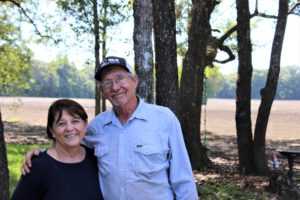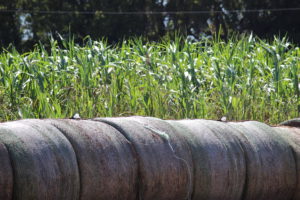
David and Gail Hodge operate their Florida farm along with their sons and their families.
By Lauren Moore, USDA
David and Gail Hodge are the owners and operators of Hodge Farms in Newberry, Florida. Established in 1919, the operation has transitioned with the ever-changing agricultural environment over the last 100 years.
A Family Farm
Originally a cotton operation, Hodge Farms was established by David’s grandfather, East Hodge. In 1936, the family started to grow tobacco, and later added watermelons and peanuts.
“Agriculture is all I’ve ever known and all I’ve ever wanted to do,” said David.
Today, the farm is a cow-calf operation that continues to grow watermelons and tobacco, in addition to blueberries, corn, and cowpeas for feed. A true family farm, David and Gail run the operation with their sons, Mark and Brad, along with their families.
“It’s a joy to work with my family in a business like this and succeed,” said Gail. “It’s not always easy, but it’s worth it.”
Valuable Lessons
Growing up on the farm, Mark and Brad learned valuable lessons that have helped them succeed as full-time farmers today. As teenagers, David and Gail gave them the opportunity to grow their own watermelons.
“They had to make decisions on how to grow them. I truly believe that letting them have a small piece of the business at that age helped them understand how to manage money and make cost-effective decisions,” Gail said. “I remember them counting the money they earned on the living room floor over and over. They were so proud.”

Hodge Farms has been in operation since 1919.
The Hodges participate in Noninsured Crop Disaster Assistance Program, administered by USDA’s Farm Service Agency, to protect their watermelons when low yields, loss of inventory, or prevented planting occur due to natural disasters. They also manage their risk through crop insurance, overseen by USDA’s Risk Management Agency.
Preparing for potential market downturns, they enroll their eligible crop acreage in the Agriculture Risk Coverage and Price Loss Coverage program, which can provide a crucial safety-net.
Thinking Out of the Box
The Hodges opened the Newberry Cornfield Maze in 2003, an event that has expanded over the last 16 years.

The Hodges have diversified their operation with the addition of agritourism and a corn maze.
Starting as a small corn maze, the Hodges have added hay rides, a haunted house, a play area for kids, a petting zoo and other attractions, topped off with human hamster balls and a mechanical bull.
To add to their growing agritourism destination, they’re wrapping up their year-long construction on a wedding and event pavilion on the farm.
“I’m a jack of all trades. I like thinking out of the box,” said Gail. “It’s needed for this job. You have to learn how to change with the economy and the environment that you’re in.”
More Information
USDA offers a variety of risk management, disaster assistance, loan, and conservation programs to help agricultural producers in the United States weather ups and downs in the market and recover from natural disasters as well as invest in improvements to their operations. Learn about additional programs.
For more information about USDA programs and services, contact your local USDA service center.
For a digital version of this blog, visit #FridaysOnTheFarm.






One Response to Transitions and Traditions on a Century-Old Farm